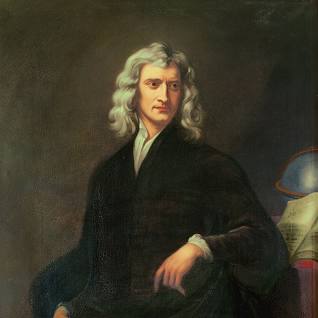
Isaac Newton
The 17th century was a period of profound intellectual awakening, a time when the embers of the Renaissance were ignited into the dazzling flames of the Scientific Revolution. Amidst this extraordinary epoch, a scientific colossus emerged whose impact on the world of knowledge remains unparalleled to this day. Born on January 4, 1643, in the modest hamlet of Woolsthorpe, England, life story of Isaac Newton is a tapestry woven with threads of brilliance, perseverance, and a relentless pursuit of understanding the universe. From humble beginnings to reshaping the foundations of physics and mathematics, Newton’s journey is one of inspiration and transformation.
Early Life Struggles and Education
Young Newton was born prematurely and, tragically, his father died just months before his birth, leaving his mother, Hannah Ayscough, to raise him alone. Growing up under the care of his grandmother, Newton’s childhood was characterized by poverty and hardship. But the inquisitive spark within him, even in his early years, displayed a thirst for knowledge that seemed destined to light up the world.
At the tender age of three, Newton’s mother remarried, and he returned to live with her and his new stepfather, Reverend Barnabas Smith. Blessed with a brilliant mind, he began attending the King’s School in Grantham, where his exceptional abilities began to shine through.
At the age of 17, young Isaac’s mother pulled him out of school to work on their family farm, intending to mold him into a successful farmer. However, destiny had other plans for the young scholar, as his heart yearned for the pursuit of knowledge and the mysteries of the natural world.
Newton’s resilience and determination to quench his intellectual thirst led to his enrollment at Trinity College, Cambridge, in 1661. While there, he was introduced to the works of philosophers like Descartes, Kepler, and Galileo, which laid the foundation for his future contributions to the world of science.
Fun Facts about Newton’s Life
1. The Legend of the Apple: One of the most enduring legends surrounding Newton’s life is that of the falling apple. As the story goes, while sitting under an apple tree, a ripe fruit struck Newton’s head, sparking a moment of epiphany that led to his discovery of the law of universal gravitation. Though there is no direct evidence to support this tale, it has become a symbol of scientific revelation and inspiration.
2. The Prism and Optics: During his time at Cambridge, Newton conducted a series of experiments with light and prisms. He demonstrated that a beam of white light could be split into its component colors, a revelation that laid the foundation for the study of optics and the development of the first reflecting telescope.
3. The Master of the Mint: Apart from his scientific pursuits, Newton’s career also saw him appointed as the Warden and later as the Master of the Royal Mint. During his tenure, he took on the challenge of combating counterfeiting, effectively reforming England’s currency and economic stability.
The Law of Universal Gravitation: The Eureka Moment
Amidst his academic commitments, Newton continued to ponder over the force that kept the planets in their celestial dance around the sun. Inspired by the works of Galileo, he sought to understand the underlying principles governing the motion of celestial bodies. Newton’s eureka moment came in 1666 when he retreated to his family estate to escape the bubonic plague ravaging England.
During this period of isolation, he delved into profound contemplation, eventually leading him to the formulation of his groundbreaking theory of universal gravitation. In his magnum opus “Philosophiæ Naturalis Principia Mathematica,” published in 1687, Newton unveiled the laws of motion and the universal law of gravitation that govern the movements of planets and objects on Earth alike.
The law of universal gravitation postulates that every object in the universe attracts every other object with a force that is directly proportional to the product of their masses and inversely proportional to the square of the distance between their centers. This groundbreaking theory shattered the long-held Aristotelian concept of motion, providing a coherent and precise explanation for planetary motion and earthly phenomena.
Contributions to the Scientific World and Stirring Change
Newton’s revolutionary work marked a paradigm shift in scientific thought and laid the foundation for modern physics and mathematics. The Principia became a cornerstone of scientific literature, unifying the understanding of celestial mechanics, and offering a robust mathematical framework for analyzing physical phenomena. It provided a clear and rigorous methodology for conducting scientific inquiry, setting the stage for future generations of scientists.
One of the most profound impacts of Newton’s work was the unification of terrestrial and celestial phenomena under a single set of laws. The concept of universal gravitation became a model for the scientific method, showcasing the power of observation, experimentation, and mathematical deduction in exploring the natural world.
Newton’s work also spurred an explosion of scientific advancements and further inquiry into the nature of light, optics, calculus, and mechanics. His formulation of calculus, developed in parallel with the German mathematician Gottfried Wilhelm Leibniz, laid the groundwork for modern mathematics and its applications in physics, engineering, and a wide range of scientific disciplines.
The Enduring Legacy of Newton
Sir Isaac Newton’s contributions to science have left an indelible mark on the fabric of human understanding, profoundly influencing subsequent generations of scientists, mathematicians, and philosophers. His ideas have become the bedrock of classical mechanics, serving as the framework upon which Albert Einstein would later build his theory of general relativity, unveiling an even deeper understanding of the universe.
Beyond his scientific achievements, Newton’s life story embodies the power of perseverance, intellectual curiosity, and the pursuit of truth. From his early struggles as a boy from a humble background to becoming one of the greatest minds in human history, Newton’s journey serves as an inspiration to dream big, work tirelessly, and challenge the boundaries of knowledge.
Conclusion
Sir Isaac Newton’s life is a tale of brilliance, perseverance, and transformation that continues to captivate the imagination of generations to come. From his early struggles against adversity to his triumphant discoveries that shook the very foundations of science, Newton stands as a luminous archetype of 17th-century scientific inquiry.
His legacy remains an enduring testament to the potential of the human mind to unlock the secrets of the universe and to inspire countless generations to reach for the stars in pursuit of knowledge and understanding.
By: Shreshtha Singh
Write and Win: Participate in Creative writing Contest & International Essay Contest and win fabulous prizes.


